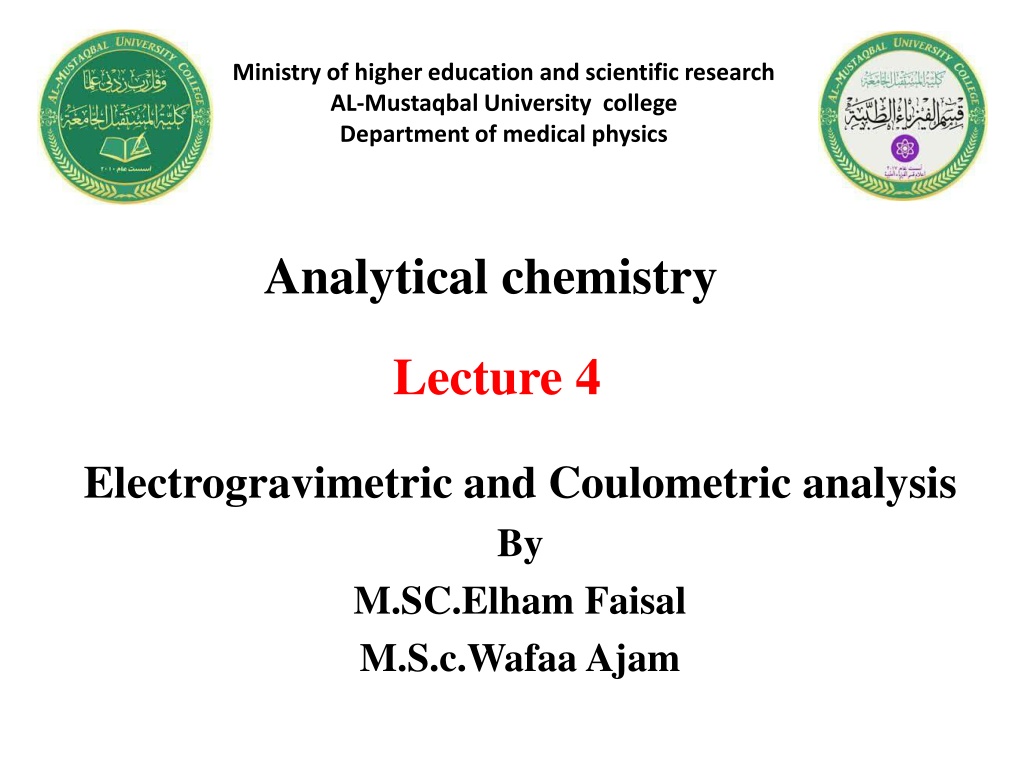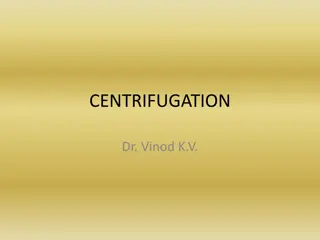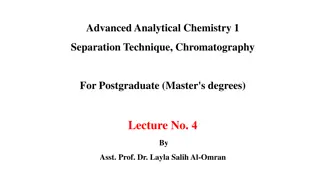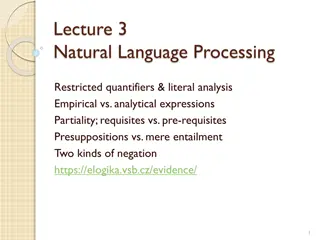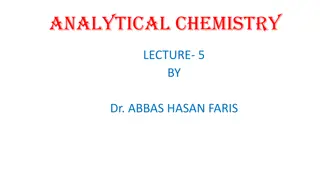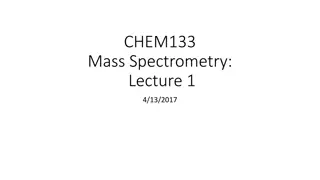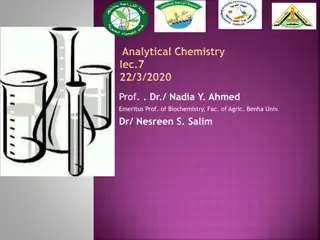Understanding Electrogravimetry for Analytical Chemistry Applications
Electrogravimetry is a technique utilized for the precise separation and quantification of metal ions in a substance. By depositing analytes on electrodes through electrochemical reduction, this method enables accurate determination of metal concentrations in solutions. It finds applications in quantitative analysis, aiding in the selective plating out and removal of different species for accurate measurements. The principle involves solid deposition from the analyte solution onto an electrode, with control of electrode potential ensuring accurate results.
Download Presentation

Please find below an Image/Link to download the presentation.
The content on the website is provided AS IS for your information and personal use only. It may not be sold, licensed, or shared on other websites without obtaining consent from the author. Download presentation by click this link. If you encounter any issues during the download, it is possible that the publisher has removed the file from their server.
E N D
Presentation Transcript
Ministry of higher education and scientific research AL-Mustaqbal University college Department of medical physics Analytical chemistry Lecture 4 Electrogravimetric and Coulometric analysis By M.SC.Elham Faisal M.S.c.Wafaa Ajam
Electrogravimetry Electrogravimetry is a method used to separate and quantify ions of a substance, usually a metal. It is a method for the separation of the metal ions by using the electrodes. Electrochemical reduction causes the analyte to be deposited on the cathode. The deposition takes place on the one electrode. The mass of the cathode is determined before and after the experiment, and the difference is used to calculate the mass of analyte in the original solution. This gives the amount of the metal present in the given sample solution. The weight of this electrode is determined before and after deposition. Controlling the potential of the electrode is important to ensure that only the metal being analyzed will be deposited on the electrode.
What are the applications of electrogravimetry? It is used for the determination of concentration of chemical elements very accurate and precisely in quantitative analysis. In a solution the different species are separated by selectively plating out and removing out. It is used in electrochemical removing interferences. methods for
PRINCIPLE The main principle involved in this method is the deposition of the solid on an electrode from the analyte solution.
Electrogravimeter The material is deposited by means of potential application. The electrons are transported to electrode by the following mechanisms: i. Diffusion. ii. Migration. iii. Convection.
What is the difference between Electrogravimetry and coulometry? In electrogravimetry, the product is weighed as a deposit on one of the electrodes. In coulometry, the quantity of electricity. needed to complete the electrolysis is measured as coulombs. Both the methods are quite sensitive, rapid and accurate.
THEORY A metal is electrolytically deposited on the electrode by increasing the mass of the electrode. M+2 + 2e M(S) Therefore, Eelectrolysis = Ecathode Eanode The electrons deposition is governed by Ohm's and Faraday's laws of electrolysis which states that the amount of the electrons deposited on the electrode is directly proportional to the amount of the current passed through the solution and the amount of different substances deposited is directly proportional to the molar masses divided by the number of electrons involved in the electrolysis process.
That is the current (I) is directly proportional to the electromotive force (E) and is indirectly proportional to the resistance (R). E = IR From the above equation, we get the following:. Eelectrolysis = Ecell IR Ecell = Ecathode Eanode where Therefore, Eapplied = Ecathode Eanode IR I = ( Eapplied/R) +1/R(Ecathode Eanode) I = (Ecell Eapplied/R) I = ( Eapplied/R) + K where K is the constant.
A plot of the current of the applied potential in an electrolytic cell should be straight line with a slope equal to negative reciprocal of the resistance
Types of Electrogravimetry Methods There are mainly two types of electrogravimetry methods: 1- Constant current electrolysis. 2- Constant potential electrolysis.
1- Constant current electrolysis: By name itself it indicates that the constant current is applied for the electrons deposition. The instrument is composed of a cell and direct current source . A 6 V battery, an ammeter and a voltameter are used. The voltage applied is controlled by a resistor. Constant current electrolysis
2-Constant potential electrolysis: In this method, the potential of the cathode is controlled. It consists of two independent electrode circuits that are connected with a common electrode. For the better results, three electrode systems re used. Working electrode: used for the deposition of the sample. Counter electrode: used as a current sink. Reference electrode: maintains the fixed potential despite the changes in solution components. Constant potential electrolysis
Electrode Used in the Electrogravimetry The electrode used in the electrogravimetry should posses the following characters: A. It should be non-reactive. B. It should be readily ignited to remove the organic matter. C. The commonly used electrode is the mercury cathode electrode for the deposition. This has the following advantages: A. It forms the amalgam with number of metals. B. It has a high hydrogen voltage. C. In this method, the precipitated elements are dissolved in the mercury. D. This method is mainly used in the removal of the reduced elements.
APPLICATIONS Used in the successive deposition of the metals. Example: Cu, Bi, Pb, Cd, Zn and Sn. Used in the simultaneous deposition of the metals. Used in the electro synthesis. Used in the purification process by removing the trace metals from the samples.
Coulometry: This method is the measurement of the quantity of the electricity. This is mainly estimated by the reaction of electrode. There are mainly two types of coulometric techniques.: 1- Controlled-potential coulometry, in which we apply a constant potential to the electrochemical cell. 2- Controlled-current coulometry, in which we pass a constant current through the electrochemical cell.
THEORY The coulometric methods are mainly based on the measurement of the quantity of the electricity. The sample which is to be determined undergoes the reaction at the electrode which is measured at the electrode. The completion of the reaction is indicated by the decrease in the current to zero. This can be measured by the coulometer. The substance which is to be determined is first electrolyzed by the constant current. Then the total current is determined by the following equation: Total current = product current time
PRINCIPLE The main principle involved in the coulometry is the measurement of the quantity of the electricity which is directly proportional to the chemical reaction at the electrode. This is given by the Faraday's first law: Where: Q is the consumed current; Mr is the relative molecular weight.
Coulmetry uses a constant current source to deliver a measured amount of charge. One mole of electrons is equal to 96,485 coulombs of charge, and is called a faraday.
Due to concentration polarization it is very difficult to completely oxidize or reduce a chemical species at an electrode. Coulometry is therefore usually done with an intermediate reagent that quantitatively reacts with the analyte. The intermediate reagent is electrochemically generated from an excess of a precursor so that concentration polarization does not occur. The point at which all of the analyte has been converted to the new oxidation state is called the endpoint and is determined by some type of indicator that is also present in the solution The analyte concentration is calculated from the reaction stoichiometry and the amount of charge that was required to produce enough reagent to react with all of the analyte.
What do you mean by concentration polarization? Concentration polarization occurs when the concentration of a specific component increases or decreases at the boundary layer close to the membrane surface due to the selective transport through the membrane.
